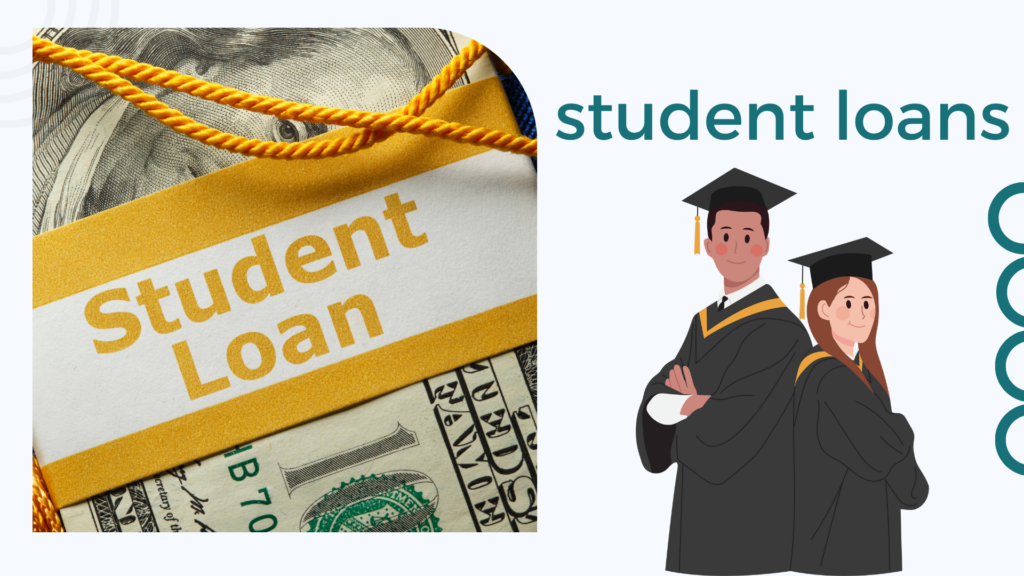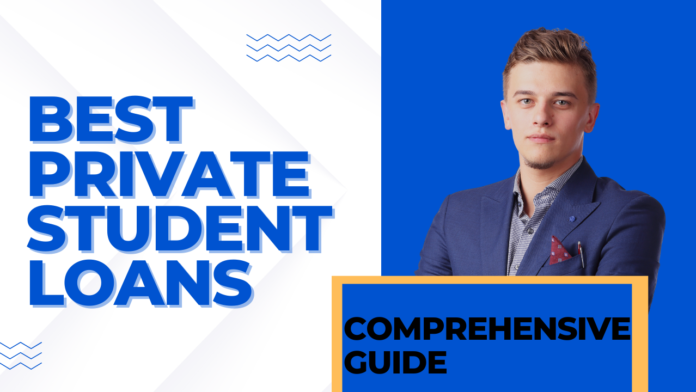Federal aid cannot address all of the university tuition outlays and how to chart a course through that sea is indeed a tough call. To afford it, many students must look for private student loans. Then in 2025, this all-inclusive guide will take you through private loans savourily, showing what you need to find out and what questions must be asked in order not make mistakes for which later on you’ll be paying dearly.
Understanding the need for private student loans:
When choosing the most suitable option, make sure you know why private student loans were created and what kinds of situations might make them a necessity. Your first stop should always be in federal student aid, including grants, scholarships and federal loans. Often these have lower interest rates and more generous terms–such as deferment until after graduation or an income-based repayment plan–than private student loans do.
Federal aid is limited. When tuition costs are above the maximum federal loan amounts, or when you have completely drained all of another source of financial aid such as state grants for college tuition and lird costs, private student loans help to fill in any gaps remaining from payments made by your family’s income. They can be used to cover the cost of tuition and fees, any on-campus room and board charges, the price for books or even extra academic equipment.
What are private student loans?

Private student loans are offered by banks, credit unions, and online lenders. Unlike federal loans, they are not guaranteed or backed by the government. This means the lender is at risk for all of the loan, which often means stricter eligibility requirements and potential higher interest rates.
Since private loans are based on credit, your credit history (or that of your co-signer) has a big influence on what interest rates you are charged and how long terms your loan will be. The better your credit rating, the lower interest rate can be agreed upon for loans—so in turn saving money over an extended period of time so as not just one payday is benefited by good fortune when that extra cost soon adds up.
Key factors to consider when choosing private student loans:
Choosing the right private student loan requires careful research and comparison. Here are some essential factors to consider:
- Interest rates: This might be perhaps the most important thing to consider Look for loans at competitive interest rates with fixed rates if possible.
- Loan terms: Looking out for loans on a variable interest basis may seem cheaper at first but market changes can unpredictably push up your monthly outgoings Loan terms vary between 5 and 20 years. A shorter term means higher monthly payments but less in total interest paid. A longer term results in lower monthly outgoings and greatly increased interest over the multi-year period Pick a term that is both within your means and keeps the total cost of the loan down.
- Fees: Be aware of any fees associated with the loan, such as origination fees, disbursement fees, or prepayment penalties. These fees can add to the overall cost of borrowing.
- Repayment options: Some lenders offer flexible repayment options, such as deferment or forbearance, which allow you to postpone payments under certain circumstances, like during graduate school or periods of unemployment. Understand the eligibility requirements and terms of these options.
- Borrower benefits: Some lenders offer additional benefits, such as interest rate discounts for automatic payments or loyalty programs for existing customers. These perks can add value to the loan.
- Co-signer requirements: Many students require a co-signer, typically a parent or guardian, to qualify for a private student loan. A co-signer shares the responsibility of repaying the loan, which can improve your chances of approval and potentially secure a lower interest rate. Understand the implications of co-signing a loan.
- Lender reputation: Choose a reputable lender with a proven track record of providing excellent customer service and transparent loan terms. Read reviews and compare lenders before making a decision.
Navigating the application process:
The application process for private student loans typically involves the following steps:
- Research and compare lenders: Use online resources and loan comparison websites to research different lenders and compare their loan terms, interest rates, and fees.
- Pre-qualification: Many lenders offer pre-qualification tools that allow you to check your eligibility and estimated interest rates without impacting your credit score. This is a great way to get an idea of your options.
- Complete the application: Once you’ve chosen a lender, complete the loan application, providing accurate information about your education, income, and credit history.
- Credit check: The lender will perform a credit check to assess your creditworthiness. If you have a co-signer, their credit will also be checked.
- Loan approval: If your application is approved, the lender will disclose the final loan terms, including the interest rate, loan amount, and repayment schedule.
- Loan disbursement: Once you’ve accepted the loan terms, the funds will be disbursed to your school or directly to you, depending on the lender’s policies.
Tips for minimizing private student loan debt:
- Maximize federal aid: Exhaust all federal aid options, including grants, scholarships, and federal loans, before considering private loans.
- Apply for scholarships: Numerous scholarships are available for students with various backgrounds and academic achievements. Take the time to research and apply for scholarships to reduce your overall borrowing needs.
- Control expenses: Create a budget and track your spending to minimize unnecessary expenses during college. Consider living with roommates or attending a less expensive school to reduce your costs.
- Consider part-time work: Working part-time during college can help you earn money to cover some of your expenses and reduce your reliance on loans.
Understanding repayment options:
Private student loan repayment options vary by lender. Be sure to understand the following:
- Grace period: Some lenders offer a grace period after graduation, during which you are not required to make payments.
- Repayment plans: Different repayment plans may be available, such as graduated repayment, income-driven repayment, or extended repayment.
- Deferment and forbearance: Understand the eligibility requirements and terms for deferment and forbearance, which allow you to temporarily postpone or reduce your payments under certain circumstances.
Private student loans vs. federal student loans:
It’s important to understand the key differences between private and federal student loans:
| Feature | Private student loans | Federal student loans |
|---|---|---|
| Lender | Banks, credit unions, online lenders | U.S. Department of Education |
| Interest Rates | Typically higher, based on creditworthiness | Typically lower, fixed rates |
| Eligibility | Credit-based, may require a co-signer | Not credit-based, most do not require a co-signer |
| Repayment Options | Less flexible | More flexible, income-driven repayment plans available |
| Loan Limits | May be higher | Lower loan limits |
| Bankruptcy | Generally not dischargeable in bankruptcy | Some discharge options available |
The future of private student loans in 2025:
The landscape of private student lending is constantly evolving. In 2025, we may see further developments in areas such as:
- Technology-driven lending: Online lenders are likely to continue to streamline the application and approval process through technology.
- Personalized loan options: Lenders may offer more personalized loan options based on individual borrower profiles and financial needs.
- Increased competition: The private student loan market may become more competitive, leading to more attractive loan terms and interest rates for borrowers.
Making informed decisions about private student loans:
While private student loans may seem like a great way to pay for your education they are actually quite tricky and difficult to manage. Before you sign anything, spend the time necessary studying all terms of different loans. Ask for loan applications from various lenders so that you can compare terms as well as interest rates and what types of repayments will be required once your school is over. Study and comparison You should do everything in your power-increase scholarships get them approved before turning to private student loans. By going after all sources of free money first and minimizing the amount of money borrowed from both private and federal student aid, you can keep your debts down to a manageable level. Instead of finding yourself weighed down with a millstone about your neck after college, take the initiative to build a career and life for which even “career-job’ people will envy you.
FAQs
What are private student loans?
Private student loans are education loans from banks, credit unions, and online lenders. They are not guaranteed by the government, like federal student loans, and usually require a credit check.
When should I consider private student loans?
Private student loans should only be used to fill gaps in funding after you’ve maxed out your federal loans, scholarships, and grants. They tend to provide competitive interest rates and flexible repayment terms for borrowers with strong credit.
What should I look for in a private student loan?
Interest Rates: Fixed versus variable rates
Repayment Terms: Seek for flexibility in repayment terms.
These can include origination fees, late payment fees or prepayment penalties.
Customer service: Look for a lender with good customer support.
Cosigner Release Options: Certain lenders allow cosigners to be released after a specific period.
Best Private Student Loan Lenders: 2025 Edition
Some lenders to consider include:
Sofi: No fees, competitive rates.
Learn More: Gives cash rewards for good grades.
Earnest: Low rates, flexible repayment terms
College Ave: Loans are customizable.
Citizens Bank: Already a customer? Get a discount.
How-do-i-qualify-for-a-private-student-loan?
Credit Score: A strong one (670 or above) makes you more likely to qualify.
Proof of income: Lenders need to verify income or employment.
Cosigner: Having a cosigner may qualify you for the loan with limited credit history.
What is the difference between fixed and variable interest rates?
Fixed Rates: These remain constant during the body of the loan, resulting in predictable payments.
Variable Rates: Rise and fall with market conditions, can be lower at the start but can cost more as the years go by.*
Is it possible to refinance private student loans?
Yes, refinancing can lower your interest rate or improve terms. But in refinancing federal loans into a private loan, you lose the federal benefits that come with it, such as income-driven repayment plans.
What fees do private student loans typically charge?
Some lenders also impose origination fees, late payment fees, or prepayment penalties. Read the fine print and go with a lender that charges little or no fees.
Will I need the presence of a cosigner to obtain a private student loan?
Yes, but that’s tougher going. You’ll also need a solid credit history and a stable income. Some lenders such as Ascent offer student loans without cosigners.


